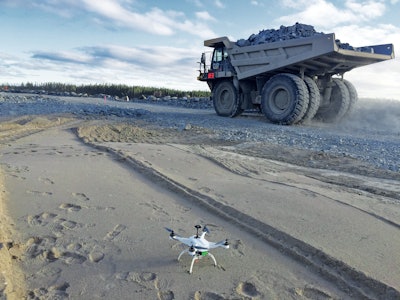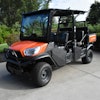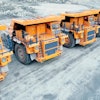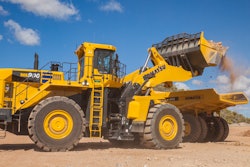
Unlike UFOs, UAVs (unmanned aerial vehicles) don’t come from outer space or carry a crew of weird little men with faces shaped like the plastic blade protection cap of a Norelco shaver.
UAVs are better known by their street name: drones. They are not the fun things you play with in the backyard, but professional commercial drones, a fast-rising technology that has spawned an entirely new construction equipment category.
In the immediate future, according to a recent report form Goldman Sachs, construction will become the largest use of drones in the Unites States.
Already the industry is flying more than 10,000 or maybe even up to 50,000 commercial drones. Whatever the exact number, say industry officials, it is significantly higher than the drone population of FAA-approved UAVs from only a few years ago. Feedback from some construction companies with fleets that include drones say they are experiencing a time-savings factor of about 75 percent.
Initial considerations for fleet managers
Drones are evolving into such a major part of fleet management that if organizations are not already using them, UAVs certainly rank very high on the to-do list. According to Bechtel’s Joshua Cotton, CEM, who spoke on the topic at AEMP’s SHIFT Conference in October, fleet executives would be wise to make their decisions as soon as possible.
“Equipment managers need to learn how these new vehicles can benefit their individual companies, how to specify which drone model is appropriate for their fleet, and how to ensure their drones are inspected, maintained, and operated,” says Cotton, Bechtel’s director of flight operations.
But, he cautions, don’t get ahead of yourself. Doing your homework on these vehicles is just as important as it is when you are making a decision on any other fleet purchase.
First of all, fleet managers need to decide whether to go it alone and handle the drone fleet internally or whether to work with a partner and outsource the responsibilities of designing a program that will provide the benefits the organization is looking for.
Once a plan is put in place, effectively execute that plan by collecting and processing data and then using that data to get the most out of your reports. Moving into this technology also requires a firm commitment to continue improving your drone program.
It's commercial aviation: take it seriously
When Bechtel recognized the value of drones, top management turned to Cotton in the equipment department since he had a pilot’s license.
“I told them, as much fun as the drone operation looks, the drone responsibility really belongs in aviation,” says Cotton. “Aviation experience is beneficial because you already know things about air space and the FAA has all the required infrastructure, although drones are not the same as corporate jets.”
Management, however, decided to keep the drone program in the equipment department.
Early in Bechtel’s UAV program, “We had people show up at our job sites carrying drones from the house and actually start flying them,” Cotton says. “The FAA is very clear on this. If you are flying drones for commercial purposes and not just for fun, you must be commercially licensed.”
Wyatt Ferguson, chief pilot and equipment specialist for Bechtel’s Equipment Operations (BEO), adds, “There is a big difference in getting a drone to fly around your house and safely flying one around your job site. Although we actually use a lot of the home-drone type, they are used in a different manner.”
“Basically, there are two types of drones: fixed wing and vertical takeoff and landing (VTOL),” Cotton says. “Some models have a sensor attached to the bottom called a light detector and range (LIDAR) that produces a very dense image. Because the image is denser, similar to laser beams, LIDAR beams can penetrate through trees and bushes and give you a much better image.”
Getting a license
Commercial drones must comply with strict FAA regulations that require commercial drone pilots to have both a FAA-certified license and the experience and proficiency to use the vehicle. Having a license is not enough. Just because someone is issued an FAA license doesn’t mean they are qualified to fly a commercial drone. In fact, a pilot can pass the license exam without even knowing how to turn on the vehicle.
The license-approval process has been cut significantly from its initial nine-month time period. “In the beginning, you had to be approved through a 333 exemption,” says Wyatt. “It was a pretty long process.”
At that time, he says, there was a total of 4,000 or 5,000 FAA approvals being issued. “But after the FAA put a much simpler process in place, construction drone use skyrocketed.”
Being issued a Part One 107 license isn’t all that hard, Ferguson says. “Getting an equipment operator's license for a large crane or other heavy construction equipment is much harder than obtaining a drone license,” he says.
“A drone license is strictly regulatory in name,” Cotton says. “All that means is you know all the rules. I would advise any fleet operator who decides to hire someone to fly his work site to ask the pilot to be able to prove his experience and proficiency.
Drone assistance
Finding information on flying commercial drones is available from a number of sources, Cotton and Ferguson say, including the FAA Advisory, which is a 54-page document containing official information; drone manufacturers and drone service providers; and even YouTube.
On the few occasions when Bechtel needs to bring in additional help on a project, it uses a company-created vetting method, which “is basically a document that tells us how providers handle their drone maintenance, how they train pilots, and how they determine the airworthiness of the vehicle,” says Cotton.
At the moment, Bechtel has eight drones in its fleet, Cotton says. “We’ve taken a hybrid approach. We have an in-house core team that we consider the center of excellence. Anything we can’t handle directly, we subcontract out to a third party.
“We staff for the valleys and subcontract out for the peaks.”
At Bechtel, UAV is growing as an equipment category as usage increases. “They really kicked in in a big way during 2014,” he says. “Bechtel’s operation received FAA approval in April 2015. We have been evolving ever since.”
How drones help fleet managers
Drones help fleet professionals on a number of fronts: monitoring work projects, conducting inspections, for safety reasons.
“It really helps to have a visual representation or spectrum on what you’re doing,” Ferguson says. “Pictures from the air give you a whole different dimension.”
And drones provide other useful data as well. They take precise measurements of projects and volume of stockpile lengths, he says. Also, aerial views give project managers a top-down view of the entire work site, some of which can be very large.
As for safety, Ferguson says, “You have an updated image that shows objects you might not see on the ground. For instance, a rock pile that could potentially twist an ankle if a surveyor has to climb to the top.
“Engineers can survey areas without putting boots on the ground,” he adds. “Drones also allow you to see such things as the locations of bodies of water or rivers. Without drones, fleet operations would have to send somebody out to manually take survey measurements.”
Another way drones can reduce risk of injury is by flying over large equipment such as cranes, Thus eliminating the necessity of taking a crane out of service and taking the boom down in order to perform the inspections.
Another plus for in-house drone operations is the reduction of rework. With frequent inspections, Ferguson says, “You can catch things before you have to do rework. We can see trends and issues start to develop before they get to the level of needing rework.”
As an example, Ferguson recalls an instance where the backside of a berm, which typically can’t be seen, was washed away. “I guess we didn’t catch it before it happened,” he says. “What was really neat about it is we had all the historical data and were able to go back and look at the series and see exactly when it did happen. “
Bechtel’s drone fleet allows the company to have complete control over the operation, quality, scheduling, risk management and safety, Ferguson says. “When we do have a situation where we outsource drones to back up our own fleet, we make sure the provider has the capacity, number of drones, pilots and current staff to commit to the projects that we want to support,” he says.
Tips on when to use drones
Knowing when to use drones is also important, Ferguson says. “They should be deployed during the very first phase of a job, before you have anything built. You want to fly over the site while it is still a grade fill. You can do a survey over the site without having surveyors walk all over the place to get contour and elevation. Then you can design off that information.
“There is a lot of bare earth information that can be stockpiled,” he says. “Once you have the earth work you start getting more vertical, erecting steel and concrete. That’s when you begin to conduct a flyover from day to day or week to week to see how the job is progressing.”
There is no question about the impact of drones on the construction industry. Not only have they created a new fleet equipment category, their contribution to fleet management equals that of other advanced technologies, such as telematics.
Construction companies are discovering that drones can fine-tune and improve their competitiveness, bidding on projects, efficiency and profit margins, plus prepare them for whatever lies ahead. Perhaps the most significant industry contribution that drones make is that they are not limited to large companies such as Bechtel. Fleet size doesn’t matter, according to Cotton.
“To try to correlate usage with fleet size would be very difficult,” he says. “This is more about the construction company itself. Actually, smaller companies, in my opinion, could benefit as much, if not more, because the drone acts as a workforce multiplier.”



















